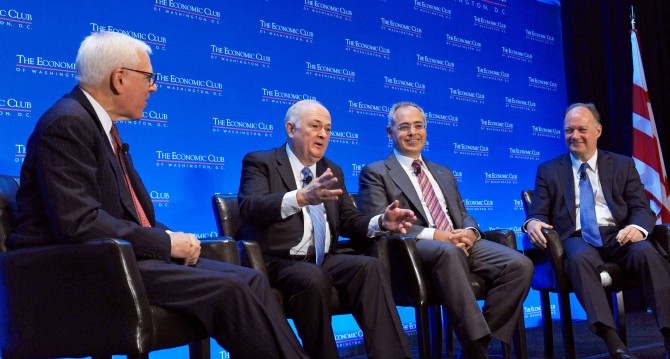With Kirk Heffelmire
Yesterday I had the pleasure of discussing the present and future of higher education with the co-founder and chief of The Carlyle Group, David Rubenstein, and two other college presidents, Georgetown University’s John DeGioia and George Washington University’s Steve Knapp, at the Economic Club of Washington, D.C. (The full 46-minute video is available here).
Underlying our discussion was the central question of excellence vs. access. So here are some additional thoughts.
Access to a college degree has become a critical public policy issue for at least two reasons: (a) a college degree has become all but mandatory to find a good job, and (b) innovation of the kind research universities produce and catalyze has become a pillar of economic competitiveness.
According to a recent report from Georgetown’s Center on Education and the Workforce, college graduates filled nearly 97 percent of the 2.9 million high-paying, full-time jobs with benefits created during the recovery from the recession. Most of these jobs were in high-skilled healthcare, STEM, and professional/managerial fields.
Yet, as the demand for college graduates grows, universities have not kept pace by providing broad and equitable access. Elite universities have used exclusivity as a signal of value at the expense of equitable access. And influential rankings like U.S. News & World Report only accentuate this phenomenon–this year’s ratings were published yesterday, by the way. We live in a knowledge economy, yet America has dangerously yielded its position as a world leader in tertiary education participation and learning outcomes. Higher education is the greatest instrument we have to facilitate social mobility, yet access to a high-quality degree continues to be closely tied to family income and wealth.
As we’ve argued several times here, universities are essential for innovation and economic competitiveness. It is estimated that up to 85 percent of the growth in U.S. per capita income can be attributed to technological change. So it is good news that American universities dominate the top of international research rankings in absolute numbers.
The key question we face, therefore, is how to resolve the access equation–how to help more Americans gain access to quality higher education regardless of socioeconomic status–while continuing to excel in scholarship and research. Our elite universities are doing fine on the latter but are unlikely to deal with the former. As Arizona State University President Michael Crow has argued, the solution to this puzzle will most likely come from large public research universities.
That is, in a nutshell, the vision of George Mason University. In a relatively short time, we have become Virginia’s largest public university, one of the most diverse, and one of the top drivers of research and innovation. We continue to grow in numbers and diversity of students while delivering increasing graduation rates, best-in-class employment outcomes, and some of the nation’s lowest student loan default rates. At the same time, we have become one of America’s 200 research-intensive universities, have increased our research expenditures by almost 60 percent from 2006 to 2013, and are ranked among the top 200 research universities in the world.
Delivering on this dual mission of inclusive excellence has not and will not be easy. But it is what keeps us going!
